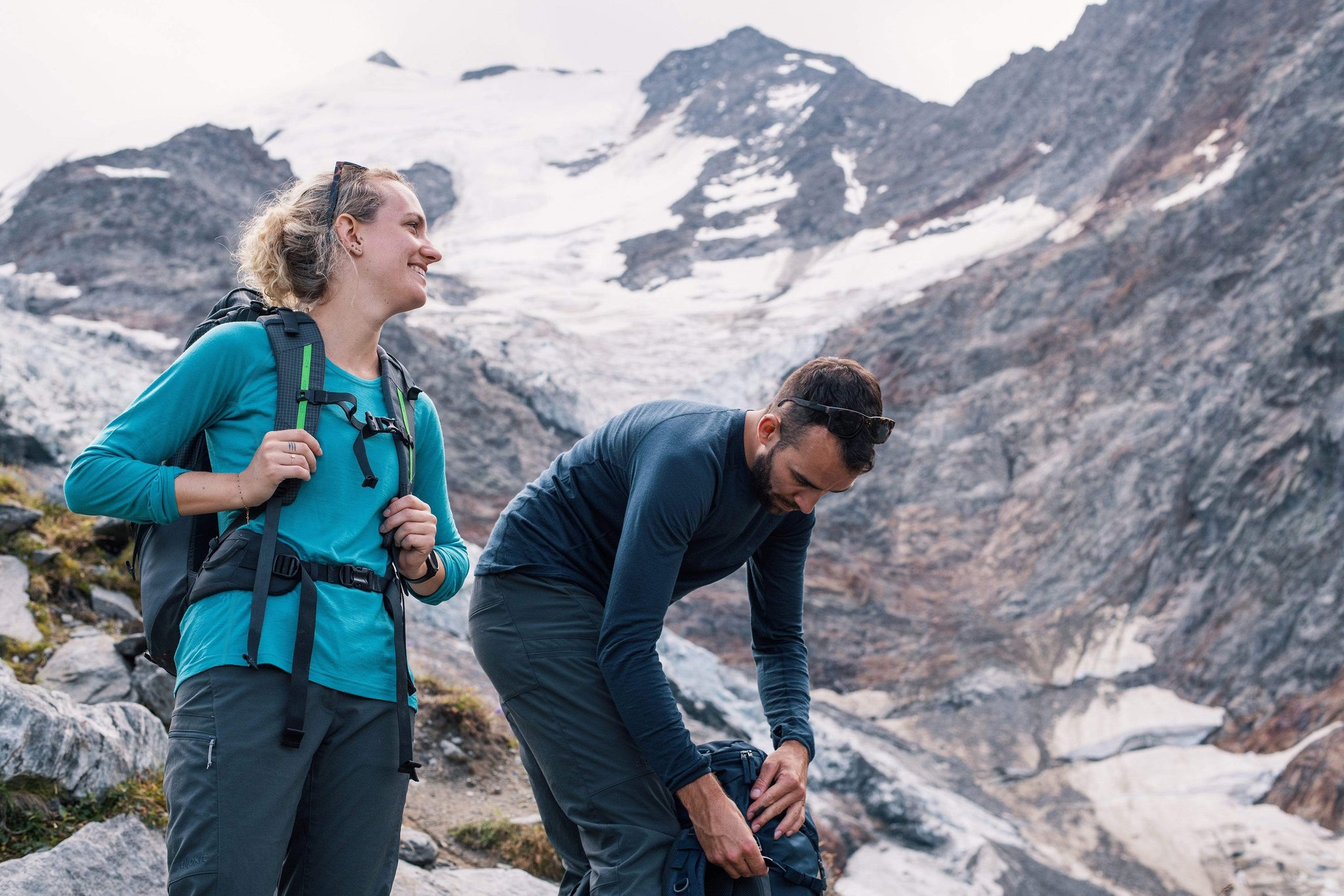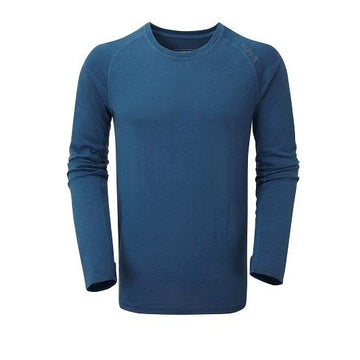
Merino wool is an ideal base layer option if you prioritise natural materials, breathability, and odour resistance. At the same time, synthetic fabrics are ideal if you prioritise affordability, quick drying, and durability.
Whether you are hillwalking, cycling, climbing or running a baselayer should form a fundamental part of your layering system. Let's look at the best baselayers in this category.
- Why choose synthetic base layers?
- Advantages of Merino wool over synthetic
- Are blended Merino wool fabrics the best of both worlds?
- What is the best base layer material, merino or synthetic fibres?

What are the advantages of synthetic base layers?
Synthetic base layers are high-wicking, fast-drying, lightweight and durable. They’re also less expensive than wool or silk. As a result, they’re now the base layer of choice for many people.
The term ‘synthetic’ actually covers a wide range of different man-made materials, each with subtly different properties. For instance, nylon (polyamide) fabrics can be more durable than polyester but are usually less breathable. Most synthetic base layers (tees and underwear) are made from polyester.
Synthetic baselayers are high-wicking and fast-drying
Synthetic fibres are hydrophobic, which means they don’t absorb much water. Because of this, they dry very quickly making them popular with paddlesports and wick sweat away from your skin, which is a major reason they make such a great base layer material for high energy output activities such as trail running and cycling.
Wicking works with your skin and any outer layers to keep you at the right temperature throughout the day and reduce chafing. Spaces in the fabric's structure pull moisture (sweat) into them by a process called ‘capillary action’ and move it to the outer surface where it can evaporate.
The rapid evaporation cools you down, preventing you from overheating. And it also stops you from getting clammy and cold when your body cools down. You might see this referred to as moisture regulating or temperature regulating, but these are just fancy terms for dealing with sweat and keeping you comfortable.

Synthetic base layers are highly durable
Part of the reason synthetic fabrics have become so widespread is due to their durability – they resist snags, tears, abrasion and pilling. This makes them ideal for climbing. They can cope with some seriously rough use and are easier to wash and care for – handy if you are travelling with limited washing/drying facilities.
Synthetics are lightweight
Because synthetic fibres are so strong, they can be knitted or woven into incredibly lightweight fabrics. This is a serious advantage for keeping your pack-size down on multi-day trips.
Kind to the skin
Fine, smooth fibres make synthetic fabrics much kinder to hypersensitive skin and suitable for people with wool allergies.

Synthetic base layers are highly breathable
Breathability is about how well a fabric allows water vapour to pass from the inside (next to your skin) to the outside (your next layer or the air outside). However, as polyester and nylon fibres don’t absorb moisture, synthetic base layers will vary quite a lot in their breathability depending on the fabric’s weight and structure.
For instance, our Vayper range uses a lightweight mesh knit which creates lots of tiny holes for excess body heat and moisture to escape. Our Koulin Trail range follows a similar principle with mesh panels under the arms and across the back. As a general rule for synthetic base layers: the more light you can see through, the more breathable it will be.

What are the advantages of Merino wool base layers?
Merino wool base layers are naturally breathable, insulating and odour-resistant. They also have some seriously cool properties which will keep you comfortable and at the right temperature in a broad range of conditions.
Merino wool is much finer than other wool fibres. To qualify as ‘Merino’, the wool fibres have to be less than 24 microns in diameter (around 1/10th of the width of a human hair). Our pure merino Kepler merino wool range is 17.2 microns. The weight of the fabric is measured in grams per square metre (gsm) – this is a good guide for how warm the base layer is.
Wool is naturally breathable
Merino wool is a living fibre that adapts to your environment and body temperature. All natural fibres can absorb and desorb moisture but wool is extremely good at it.
Wool does this by absorbing moisture vapour into the structure of the fibre itself, before expelling it into the outside air. This helps to keep your temperature level in the same way as wicking – evaporating sweat to cool you down when you overheat, and keeping your skin surface dry to keep you warm when you cool down.
In fact, wool fibres can absorb up to 35% of their weight in water before feeling damp to the touch. When your base layer can’t absorb any more moisture, its fibres will wick in the same way as synthetic fibres.
Wool is temperature regulating
Breathable wool fabrics control the rate of evaporation much better than synthetic ones. Wool releases moisture from its fibres quickly when your body surface is hot and damp and slows down when it’s cold and dry.
There’s also a clever chemical reaction that releases heat when water molecules react with molecules in the wool fibre. This protects against rapid cooling when you get really sweaty after a hard climb.

Merino wool is naturally insulating
Wool fibres have a natural waviness (or ‘crimp’) which creates lots of pockets of insulating air when they’re layered together. The finer the fibre, the wavier it is, and the more air pockets it creates. This gives fine merino wool an excellent warmth-to-weight ratio.
Because Merino wool fibres are so springy, they don’t lose these pockets of air when they get wet, providing insulation even when damp.
Next to skin comfort
Because Merino wool fibres are so fine, they are softer than standard wool and itch-free for all but the most sensitive of skin. It’s hard to explain why, but Merino wool base layers also feel much nicer to wear than man-made fabrics.
And because the fibres can absorb so much moisture before the fabric starts to feel damp, Merino wool base layers rarely feel clammy against the skin – unless you’ve been sweating absolute buckets!
Merino wool is naturally odour-resistant
Wool has inbuilt stink-fighting, unlike synthetic base layers which need a treatment like Polygiene to stay fresh. By keeping your skin surface dry, wool reduces the growth of odour-causing bacteria in the first place. But wool also traps odours inside the structure of its fibres, releasing them only when the garment is washed. On top of that, research has also shown that Merino fibres provide a less hospitable environment for odour-causing bacteria than synthetics.
Biodegradable
As a natural fibre, Merino wool will biodegrade under the right conditions rather than hanging around in the environment for many years.
Fire retardant
Merino wool is naturally flame-resistant. This means that it will not melt or stick upon coming into contact with fire.

What are blended merino fabrics?
Blended fabrics combine the natural advantages of Merino wool with the durability and easy care of synthetic fabrics. Blended base layers are the best all-rounders.
We use a technology called ‘corespun’ for our Merino underwear, gloves and hats, wrapping a nylon and spandex core with merino wool. Still 86% Merino, this makes the fabric more durable and more elastic for a better fit and recovery after use.

What is the best base layer material?
Merino wool and synthetic base layers both have a place in your wardrobe
, says Alpkit Design Manager Ronnie. Which one you choose depends on the activity, conditions, and trip length.
You’ll probably find you have a preference for one or the other for different activities or at different times of the year. So, don't sweat it!
When a synthetic base layer is the best choice
Synthetic base layers are ideally suited to warm weather or high-intensity activities like trail running and cycling. Their high-wicking and fast-drying fabrics keep you cool and dry and reduce the risk of chafing or overheating. Because the fibres don’t absorb water, they won’t get overpowered by sweat and become heavy.
When a merino base layer is the best choice
Merino wool base layers are best suited to mild – cold weather or stop-start activities like hiking and climbing. Merino wool’s natural breathability and temperature control properties keep you more comfortable in a wide range of conditions, even when you slow down. Because of their odour resistance, merino wool base layers are perfect for multi-day backpacking and bikepacking trips (mostly just to spare everyone you come into contact with!). Higher gsm merino base layers can add vital warmth to layering systems for winter sports like mountaineering, ice climbing or skiing.






